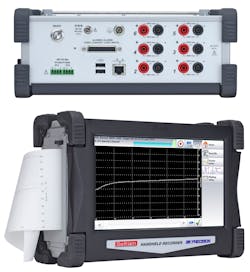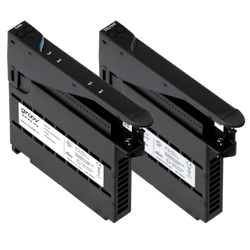Data recorders, sensor transmitters, and I/O modules bring temperature measurement and control into the digital world
Download this article in .PDF format.
Mention temperature measurement to average persons, and they will likely visualize a mercury-in-glass thermometer. They might not know that it was invented in the early 18th century in Amsterdam by Daniel Gabriel Fahrenheit, but they will be familiar with Fahrenheit’s temperature scale, which, after some fine-tuning, places water’s freezing point at 32°F and its boiling point at 212°F, or 180°F higher than the freezing point.
Fahrenheit’s scale continues to hold sway in the United States, although the Celsius scale predominates elsewhere. But alas, the mercury-in-glass thermometer, which had represented the state-of-the-art since its invention in 1714, is being phased out in the 21st century because of mercury’s toxicity. As a sign of the mercury thermometer’s demise, NIST reports that it began an active mercury-reduction campaign in 2007 and stopped calibrating mercury thermometers entirely on March 1, 2011.1
NIST emphasizes that it continues to offer thermometric calibration services for nonmercury devices, including organic-liquid-in-glass thermometers, which you can still purchase. Curiously, Fahrenheit is credited with having helped to perfect an alcohol-in-glass thermometer before turning his attention to the mercury-based instrument.
Of course, liquid-in-glass thermometers—organic or mercury—have never been ideal for the types of experiments conducted in an electronics test lab or environmental test chamber. Liquid-in-glass thermometers are fragile, they have slow equilibrium and response times, and they don’t offer electrical outputs that could serve as inputs for old analog chart recorders or that could be digitized at fast update rates for modern data loggers and computer analysis. The attention has turned to devices such as thermocouples (TCs), resistance temperature detectors (RTDs), and thermistors.
Thermocouples and Seebeck
Although not as old as liquid-in-glass thermometers, thermocouples are not new. Their existence extends back to observations in 1821 by the German physicist Thomas Johann Seebeck that a temperature gradient across a conductor induces an electromotive force. In a thermocouple, the bare ends of two insulated wires of dissimilar metals are welded together to form a tip, which can be affixed to a device under test whose temperature is to be measured. The same temperature gradient across the different wires will induce a different voltage. Consequently, the voltage differential measured at the other end of the equal-length wires at a controlled reference temperature (the cold junction) can then be used to calculate the DUT temperature.
Thermocouples come in a variety types (each designated by a letter) with different pairs of metals. Type J, for example, combines iron and constantan, the latter being a copper-nickel alloy. Commonly used types in addition to J include B, E, K, N, R, S, T, and C, whose makeup and characteristics are in accordance with standards set by ASTM International.3
RTDs and thermistors
RTDs and thermistors are conceptually easier to understand. RTDs, such as platinum resistance thermometers (PRT), take advantage of the fact that the resistance of a metal (platinum, for example) increases with temperature. They lack the extreme temperature ranges of thermocouples. For example, NIST reports that it calibrates these devices from -196°C to 550°C.4
RTDs tend to have low resistances. The Pt100 PRT, for example, has a resistance of 100 Ω at 0°C (hence the 100 following the periodic-table symbol for platinum in the designation), and NIST notes that a conventional PRT may have a resistance of about 80 Ω at -50°C and 120 Ω at 50°C, for a sensitivity of about 0.4 Ω/°C. With low PRT resistances, measurement lead-wire resistance can introduce significant errors. National Instruments describes 3- and 4-wire configurations that can minimize errors due to lead resistance and lead-resistance inconsistencies.5 An alternative is to use a Pt1000 PRT, which has a resistance of 1,000 Ω at 0°C, making measurement lead resistance less of a factor.
Finally, thermistors employ semiconductor materials instead of metals like platinum and can offer positive or—more typically—negative temperature coefficients (resistance falls as temperature increases). They can offer higher sensitivities than RTDs, albeit over a narrower temperature range. For example, NIST reports calibrating these devices from -50°C to 100°C. Thermistors can serve in thermocouple applications to accurately monitor the cold-junction reference temperature for use in calculating the DUT temperature.
Recording and control
Once your sensor has measured temperature, you’ll want to do something with the result. You may want to record it, for example, for later analysis. If your sensor is in a remote location, you may want to transmit its output elsewhere. Finally, you may want to take some action based on measured temperatures. Three new products introduced in December 2019 cover all three bases.
First, B&K Precision announced the expansion of its data-recorder line with the new DAS30/50/60 family, developed by B&K Precision's subsidiary Sefram in France, which specializes in the design and manufacture of data-acquisition instruments and other test and measurement solutions.
The DAS30/50/60 data recorders feature two, four, or six analog input channels, a sampling interval of 1 µs (1 MS/s), an input range of ±5 mV to ±500 V, and internal solid-state memory of up to 64 GB. Combined with the CAT III isolation rating, these instruments are suited for a range of applications from sensor signal logging to electrical power analysis. A built-in power-analysis application measures and records voltage and current on both single- and 3-phase networks. The results are displayed as a harmonics graph, Fresnal diagram, or oscilloscope waveform.
Specifically for temperature measurement, B&K Precision offers Pt100 and Pt1000 inputs as a factory option on the DAS30 and DAS50 models and as standard for the DAS60. An integrated thermal printer is a factory option on all three models.
Sensor signal transmitter
For transmitting a signal, OMEGA introduced its XW Series wireless sensor/transmitter system, which provides seamless connectivity across the company’s catalog of sensors. The devices can serve demanding industrial applications indoors and survive harsh outdoor environments. The electronics are protected in a rugged weatherproof NEMA 4 (IP65)-rated housing and are easy to set up using a standard USB cable in conjunction with free SYNC configuration software. A variety of compatible probes and sensors mate quickly and easily with robust M12 connectors.
The XW series provides options for compatibility with both digital and analog sensor types. The XW-ED accepts a variety of smart digital probes and accommodates pulse and process inputs. The XW-EDA model supports a range of thermocouples, RTDs, and precision process inputs. Pro versions feature two additional configurable discrete inputs/outputs, which enable edge-control capability. The product can be configured to use local sensor data to provide closed-loop control to local equipment, as well as sounding alarms or monitoring door switches.
"I am pleased that we have created a high-performance wireless platform that supports more than 80% of Omega’s sensor portfolio, including our extensive line of thermocouples and RTDs,” said Peter Schwartz, senior product manager for IIoT, in a press release. “These products are ideal for both new sensor installations and adding IIoT connectivity to existing ones.”
Programmable control
GRV-ITM-12 (analog input, 12 channels, and thermocouple or millivolt inputs) provides a high-density, low-cost temperature-sensing option with two isolated zones and six channels per zone. Each channel is software-configurable to one of seven millivolt ranges or eight thermocouple types (B, E, J, K, N, R, S, T). GRV-ITM-12 is accurate to 0.1% of the configured range over 20-bit resolution for V/mV sensing, with accuracy ranging from 2.0 to 5.0 °C for thermocouple sensing.
The new modules complement three modules introduced in October, including the 8-channel analog-input GRV-IRTD-8, which increases options for accuracy and I/O density in temperature applications, the company reported. It provides eight channels for 2- and 3-wire RTD inputs, with a maximum range of -200°C to 850°C. Users can take advantage of multiple fixed ranges or one of two autoranging methods to simplify configuration. The GRV-IRTD-8 can also be used for high-resolution resistance measurements, with accuracy ranging from 4.2 Ω at the 8-kΩ input range to 0.058 Ω at the 10-Ω range for 3-wire RTDs.
REFERENCES
1. “Mercury Thermometer Alternatives,” Physical Measurement Laboratory, NIST, Updated December 10, 2019.
2. “Mercury Thermometer Alternatives: Thermocouple,” Physical Measurement Laboratory, NIST, Updated December 10, 2019.
3. ASTM E230 / E230M - 17: Standard Specification for Temperature-Electromotive Force (emf) Tables for Standardized Thermocouples, ASTM International, West Conshohocken, PA, 2017.
4. “Mercury Thermometer Alternatives: Platinum Resistance Thermometers (PRTs),” Physical Measurement Laboratory, NIST, Updated December 10, 2019.
5. “Temperature Sensor Basics,” White Paper, National Instruments, Updated March 14, 2019.
6. “Mercury Thermometer Alternatives: Thermistor,” Physical Measurement Laboratory, NIST, Updated December 10, 2019.



